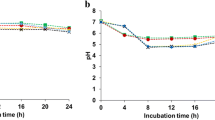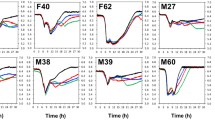Abstract
Only about one third of humans possess a microbiota capable of transforming the dietary isoflavone daidzein into equol. Little is known about the dietary and physiological factors determining this ecological feature. In this study, the in vitro metabolism of daidzein by faecal samples from four human individuals was investigated. One culture produced the metabolites dihydrodaidzein and O-desmethylangolensin, another produced dihydrodaidzein and equol. From the latter, a stable and transferable mixed culture transforming daidzein into equol was obtained. Molecular fingerprinting analysis (denaturing gradient gel electrophoresis) showed the presence of four bacterial species of which only the first three strains could be brought into pure culture. These strains were identified as Lactobacillus mucosae EPI2, Enterococcus faecium EPI1 and Finegoldia magna EPI3, and did not produce equol in pure culture. The fourth species was tentatively identified as Veillonella sp strain EP. It was found that hydrogen gas in particular, but also butyrate and propionate, which are all colonic fermentation products from poorly digestible carbohydrates, stimulated equol production by the mixed culture. However, when fructo-oligosaccharides were added, equol production was inhibited. Furthermore, the equol-producing capacity of the isolated culture was maintained upon its addition to a faecal culture originating from a non-equol-producing individual.





Similar content being viewed by others
References
Adlercreutz H (1995) Phytoestrogens—epidemiology and a possible role in cancer protection. Environ Health Perspect 103:103–112
Akaza H, Miyanaga N, Takashim N, Naito S, Hirao Y, Tsukamoto T, Fujioka T, Mori M, Kim WJ, Song JM, Pantuck AJ (2004) Comparisons of percent equol producers between prostate cancer patients and controls: case-controlled studies of isoflavones in Japanese, Korean and American residents. Jpn J Clin Oncol 34:86–89
Altschul SF, Madden TL, Schaffer AA, Zhang JH, Zhang Z, Miller W, Lipman DJ (1997) Gapped BLAST and PSI-BLAST: a new generation of protein database search programs. Nucleic Acids Res 25:3389–3402
Atkinson C, Berman S, Humbert O, Lampe JW (2004) In vitro incubation of human feces with daidzein and antibiotics suggests interindividual differences in the bacteria responsible for equol production. J Nutr 134:596–599
Axelson M, Sjovall J, Gustafsson BE, Setchell KDR (1984) Soya - a dietary source of the non-steroidal estrogen equol in man and animals. J Endocrinol 102:49–56
Boon N, Goris J, De Vos P, Verstraete W, Top EM (2000) Bioaugmentation of activated sludge by an indigenous 3-chloroaniline-degrading Comamonas testosteroni strain, I2gfp. Appl Environ Microbiol 66: 2906–2913
Bowey E, Adlercreutz H, Rowland I (2003) Metabolism of isoflavones and lignans by the gut microflora: a study in germ-free and human flora associated rats. Food Chem Toxicol 41:631–636
Chang YC, Nair MG (1995) Metabolism of daidzein and genistein by intestinal bacteria. J Nat Prod 58:1892–1896
Chen J, Lin HM, Hu M (2003) Metabolism of flavonoids via enteric recycling: role of intestinal disposition. J Pharmacol Exp Ther 304:1228–1235
Christl SU, Murgatroyd PR, Gibson GR, Cummings JH (1992) Production, metabolism, and excretion of hydrogen in the large intestine. Gastroenterology 102:1269–1277
Coward L, Barnes NC, Setchell KDR, Barnes S (1993) Genistein, daidzein, and their beta-glycoside conjugates—antitumor isoflavones in soybean foods from American and Asian diets. J Agric Food Chem 41:1961–1967
Cummings JH, Macfarlane GT, Englyst HN (2001) Prebiotic digestion and fermentation. Am J Clin Nutr 73:415S-420S
Day AJ, Canada FJ, Diaz JC, Kroon PA, McLauchlan R, Faulds CB, Plumb GW, Morgan MRA, Williamson G (2000) Dietary flavonoid and isoflavone glycosides are hydrolysed by the lactase site of lactase phlorizin hydrolase. FEBS Lett 468:166–170
Dolfing J, Gottschal JC (1997) Microbe-microbe interactions. In: Mackie RI, White BA, Isaacson RE (eds) Gastrointestinal microbiology. Chapman and Hall, New York, pp 373–433
Duncan SH, Barcenilla A, Stewart CS, Pryde SE, Flint HJ (2002) Acetate utilization and butyryl coenzyme A (CoA): acetate-CoA transferase in butyrate-producing bacteria from the human large intestine. Appl Environ Microbiol 68:5186–5190
Florin THJ, Zhu G, Kirk KM, Martin NG (2000) Shared and unique environmental factors determine the ecology of methanogens in humans and rats. Am J Gastroenterol 95:2872–2879
Fooks LJ, Fuller R, Gibson GR (1999) Prebiotics, probiotics and human gut microbiology. Int Dairy J 9:53–61
Gibson GR, Roberfroid MB (1995) Dietary modulation of the human colonic microbiota—introducing the concept of prebiotics. J Nutr 125:1401–1412
Gibson GR, Cummings JH, Macfarlane GT, Allison C, Segal I, Vorster HH, Walker ARP (1990) Alternative pathways for hydrogen disposal during fermentation in the human colon. Gut 31:679–683
Heinonen S, Wahala K, Adlercreutz H (1999) Identification of isoflavone metabolites dihydrodaidzein, dihydrogenistein, 6′-OH-O-dma, and cis-4-OH-equol in human urine by gas chromatography-mass spectroscopy using authentic reference compounds. Anal Biochem 274:211–219
Hopkins MJ, Macfarlane GT (2003) Nondigestible oligosaccharides enhance bacterial colonization resistance against Clostridium difficile in vitro. Appl Environ Microbiol 69:1920–1927
Hur HG, Lay JO, Beger RD, Freeman JP, Rafii F (2000) Isolation of human intestinal bacteria metabolizing the natural isoflavone glycosides daidzin and genistin. Arch Microbiol 174:422–428
Hur HG, Beger RD, Heinze TM, Lay JO, Freeman JP, Dore J, Rafii F (2002) Isolation of an anaerobic intestinal bacterium capable of cleaving the C-ring of the isoflavonoid daidzein. Arch Microbiol 178:8–12
Kelly GE, Joannou GE, Reeder AY, Nelson C, Waring MA (1995) The variable metabolic response to dietary isoflavones in humans. Proc Soc Exp Biol Med 208:40–43
Kleessen B, Sykura B, Zunft HJ, Blaut M (1997) Effects of inulin and lactose on fecal microflora, microbial activity, and bowel habit in elderly constipated persons. Am J Clin Nutr 65:1397–1402
Kostelac D, Rechkemmer G, Briviba K (2003) Phytoestrogens modulate binding response of estrogen receptors alpha and beta to the estrogen response element. J Agric Food Chem 51:7632–7635
Kuiper G, Carlsson B, Grandien K, Enmark E, Haggblad J, Nilsson S, Gustafsson JA (1997) Comparison of the ligand binding specificity and transcript tissue distribution of estrogen receptors alpha and beta. Endocrinology 138:863–870
Kuiper G, Lemmen JG, Carlsson B, Corton JC, Safe SH, van der Saag PT, van der Burg P, Gustafsson JA (1998) Interaction of estrogenic chemicals and phytoestrogens with estrogen receptor beta. Endocrinology 139:4252–4263
Kurzer MS, Xu X (1997) Dietary phytoestrogens. Annu Rev Nutr 17:353–381
Lampe JW (2003) Isoflavonoid and lignan phytoestrogens as dietary biomarkers. J Nutr 133:956S–964S
Lampe JW, Skor HE, Li S, Wahala K, Howald WN, Chen C (2001) Wheat bran and soy protein feeding do not alter urinary excretion of the isoflavan equol in premenopausal women. J Nutr 131:740–744
Liu TZ, Lee SD, Bhatnagar RS (1979) Toxicity of palladium. Toxicol Lett 4:469–473
Lund TD, Munson DJ, Haldy ME, Setchell KDR, Lephart ED, Handa RJ (2004) Equol is a novel anti-androgen that inhibits prostate growth and hormone feedback. Biol Reprod 70:1188–1195
Macfarlane S, Macfarlane GT (2003) Regulation of short-chain fatty acid production. Proc Nutr Soc 62:67–72
Messina MJ, Persky V, Setchell KDR, Barnes S (1994) Soy intake and cancer risk - a review of the in vitro and in vivo data. Nutr Cancer 21: 113–131
Meyer BJ, Larkin TA, Owen AJ, Astheimer LB, Tapsell LC, Howe PRC (2004) Limited lipid-lowering effects of regular consumption of whole soybean foods. Ann Nutr Metabol 48:67–78
Mitchell JH, Gardner PT, McPhail DB, Morrice PC, Collins AR, Duthie GG (1998) Antioxidant efficacy of phytoestrogens in chemical and biological model systems. Arch Biochem Biophys 360:142–148
Morito K, Hirose T, Kinjo J, Hirakawa T, Okawa M, Nohara T, Ogawa S, Inoue S, Muramatsu M, Masamune Y (2001) Interaction of phytoestrogens with estrogen receptors alpha and beta. Biol Pharm Bull 24:351–356
Murphy PA, Barua K, Hauck CC (2002) Solvent extraction selection in the determination of isoflavones in soy foods. J Chromatogr B 777:129–138
Muthyala RS, Ju YH, Sheng SB, Williams LD, Doerge DR, Katzenellenbogen BS, Helferich WG, Katzenellenbogen JA (2004) Equol, a natural estrogenic metabolite from soy isoflavones: convenient preparation and resolution of R- and S-equols and their differing binding and biological activity through estrogen receptors alpha and beta. Bioorg Med Chem 12:1559–1567
Ohta A, Uehara M, Sakai K, Takasaki M, Adlercreutz H, Morohashi T, Ishimi Y (2002) A combination of dietary fructooligosaccharides and isoflavone conjugates increases femoral bone mineral density and equol production in ovariectomized mice. J Nutr 132:2048–2054
Peters NK, Frost JW, Long SR (1986) A plant flavone, luteolin, induces expression of Rhizobium meliloti nodulation genes. Science 233:977–980
Phillips D (1992) Flavonoids: plant signals to soil microbes. Annu Rev Phytochem 26:201–231
Possemiers S, Verthe K, Uyttendaele S, Verstraete W (2004) PCR-DGGE-based quantification of stability of the microbial community in a simulator of the human intestinal microbial ecosystem. FEMS Microbiol Ecol 25:1797–1805
Rafii F, Davis C, Park M, Heinze TM, Beger RD (2003) Variations in metabolism of the soy isoflavonoid daidzein by human intestinal microfloras from different individuals. Arch Microbiol 180:11–16
Richelle M, Priclmore-Merten S, Bodenstab S, Enslen M, Offord EA (2002) Hydrolysis of isoflavone glycosides to aglycones by beta-glycosidase does not alter plasma and urine isoflavone pharmacokinetics in postmenopausal women. J Nutr 132:2587–2592
Rowland I, Wiseman H, Sanders TAB, Adlercreutz H, Bowey EA (2000) Interindividual variation in metabolism of soy isoflavones and lignans: influence of habitual diet on equol production by the gut microflora. Nutr Cancer 36:27–32
Rowland I, Faughnan M, Hoey L, Wahala K, Williamson G, Cassidy A (2003) Bioavailability of phyto-oestrogens. Br J Nutr 89:S45–S58
Sathyamoorthy N, Wang TTY (1997) Differential effects of dietary phyto-oestrogens daidzein and equol on human breast cancer MCF-7 cells. Eur J Cancer 33:2384–2389
Schoefer L, Mohan R, Braune A, Birringer M, Blaut M (2002) Anaerobic C-ring cleavage of genistein and daidzein by Eubacterium ramulus. FEMS Microbiol Lett 208:197–202
Setchell KDR, Brown NM, Lydeking-Olsen E (2002) The clinical importance of the metabolite equol—a clue to the effectiveness of soy and its isoflavones. J Nutr 132:3577–3584
Setchell KDR, Faughnan MS, Avades T, Zimmer-Nechemias L, Brown NM, Wolfe BE, Brashear WT, Desai P, Oldfield MF, Botting NP, Cassidy A (2003) Comparing the pharmacokinetics of daidzein and genistein with the use of C-13-labeled tracers in premenopausal women. Am J Clin Nutr 77:411–419
Steer TE, Johnson IT, Gee JM, Gibson GR (2003) Metabolism of the soyabean isoflavone glycoside genistin in vitro by human gut bacteria and the effect of prebiotics. Br J Nutr 90:635–642
Tew BY, Xu X, Wang HJ, Murphy PA, Hendrich S (1996) A diet high in wheat fiber decreases the bioavailability of soybean isoflavones in a single meal fed to women. J Nutr 126:871–877
Wang HJ, Murphy PA (1994) Isoflavone content in commercial soybean foods. J Agric Food Chem 42:1666–1673
Wiseman H (1999) The bioavailability of non-nutrient plant factors: dietary flavonoids and phyto-oestrogens. Proc Nutr Soc 58:139–146
Wolin MJ, Miller TL (1983) Carbohydrate fermentation. In: Da H (ed) Human intestinal microflora in health and disease. Academic, New York, pp 147–165
Xu X, Harris KS, Wang HJ, Murphy PA, Hendrich S (1995) Bioavailability of soybean isoflavones depends upon gut microflora in women. J Nutr 125:2307–2315
Zafar TA, Weaver CM, Jones K, Moore DR, Barnes S (2004) Inulin effects on bioavailability of soy isoflavones and their calcium absorption enhancing ability. J Agric Food Chem 52:2827–2831
Zumdahl S (1998) Chemical principles. Houghton Mifflin, Boston
Acknowledgements
The authors want to thank G. Diekert, A. Neumann and Y.Greiner from the Friedrich-Schiller Universität (Jena, Germany) for their intellectual and technical assistance; K. Crul for technical assistance and T. Van de Wiele, S. Possemiers and K. Verthé for critically reading the manuscript. This study was conducted in cooperation with Acatris Holding BV (Giessen, The Netherlands). K.D. benefits from an IWT scholarship (Flemish Institute for Innovation in Science and Technology).
Author information
Authors and Affiliations
Corresponding author
Rights and permissions
About this article
Cite this article
Decroos, K., Vanhemmens, S., Cattoir, S. et al. Isolation and characterisation of an equol-producing mixed microbial culture from a human faecal sample and its activity under gastrointestinal conditions. Arch Microbiol 183, 45–55 (2005). https://doi.org/10.1007/s00203-004-0747-4
Received:
Revised:
Accepted:
Published:
Issue Date:
DOI: https://doi.org/10.1007/s00203-004-0747-4




